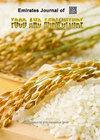Vitis vinifera L. variety Syrah sprayed with ZnSO4: Effect on fruit quality and winemaking
IF 0.7
4区 农林科学
Q3 AGRONOMY
引用次数: 0
Abstract
In grapevines, Zn is essential for normal leaf growth, shoot elongation and pollen development, allowing a fully developed berry. In this context, using as a test system Vitis vinifera L. variety Syrah, this study aimed to assess the interactions between Zn enrichment in grapes and sugars and fatty acids profiles, further considering the sensory implications of red wine production. Vineyard conditions of the soil were assessed to ensure the natural optimal development of grapevines and the workflow for Zn enrichment considered three treatments: foliar spray with water (control) and with ZnSO4 (at 450 and 900g.ha-1). After the 2nd foliar application of ZnSO4, only minor changes of Zn, Ca and P contents were found in grapes (the levels of K, Cu and S increased significantly with ZnSO4 (450 g.ha-1). At harvest, the grapes submitted to foliar application of ZnSO4 showed significantly higher levels of Zn (between 33.38 - 54.41%), but significant deviations in sugars (sucrose, glucose and fructose), fatty acids (C18:0, C18:1, C18:2, C18:3, C16:0, C<16:0) and color parameters were not found. After winemaking, relative to the control, a higher content of Zn persisted (60.59 - 63.82%), without impairing the characteristics desired by consumers. In fact, the wine with ZnSO4 (900 g.ha-1) was the most sensorially accepted. Keywords: Foliar spraying with ZnSO4; Grapes enrichment with Zn; Nutrient’s interactions; Sugars and fatty acids profiles; Vitis vinifera L. variety Syrah; Winemaking.喷洒了硫酸锌的葡萄品种西拉:对果实质量和酿酒的影响
在葡萄树中,锌对正常的叶片生长、枝条伸长和花粉发育以及浆果的充分发育至关重要。在此背景下,本研究以葡萄品种西拉(Syrah)为测试系统,旨在评估葡萄中锌富集与糖和脂肪酸之间的相互作用,并进一步考虑红葡萄酒生产的感官影响。对葡萄园的土壤条件进行了评估,以确保葡萄树的自然最佳发展,富锌的工作流程考虑了三种处理方法:用水叶面喷施(对照)和硫酸锌叶面喷施(450 克/公顷和 900 克/公顷)。 第 2 次叶面喷施硫酸锌后,葡萄中的锌、钙和磷含量只发生了轻微变化(硫酸锌(450 克/公顷)会显著增加钾、铜和硒的含量)。收获时,叶面喷施 ZnSO4 的葡萄锌含量明显增加(33.38 - 54.41%),但糖分(蔗糖、葡萄糖和果糖)、脂肪酸(C18:0、C18:1、C18:2、C18:3、C16:0、C<16:0)和颜色参数没有发现明显偏差。酿酒后,与对照组相比,锌的含量更高(60.59 - 63.82%),但并不影响消费者所期望的特性。事实上,添加 ZnSO4(900 g.ha-1)的葡萄酒在感官上最容易被接受。 关键词叶面喷洒硫酸锌;富含锌的葡萄;养分的相互作用;糖分和脂肪酸含量;葡萄品种西拉;葡萄酒酿造。
本文章由计算机程序翻译,如有差异,请以英文原文为准。
求助全文
约1分钟内获得全文
求助全文
来源期刊

Emirates Journal of Food and Agriculture
AGRONOMYFOOD SCIENCE & TECHNOLOGY&nb-FOOD SCIENCE & TECHNOLOGY
CiteScore
1.80
自引率
0.00%
发文量
18
期刊介绍:
The "Emirates Journal of Food and Agriculture [EJFA]" is a unique, peer-reviewed Journal of Food and Agriculture publishing basic and applied research articles in the field of agricultural and food sciences by the College of Food and Agriculture, United Arab Emirates University, United Arab Emirates.
 求助内容:
求助内容: 应助结果提醒方式:
应助结果提醒方式:


